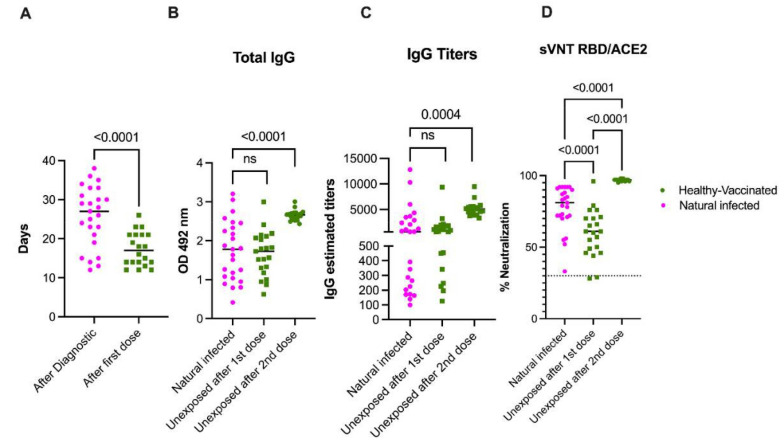Figure 2.
Naturally acquired SARS-CoV-2 infection primes an immune response superior to a single COVID-19 vaccine dose. Panel (A) shows the mean time of sample collection following natural infection (n = 25) or after the first vaccine dose (n = 20). In panels (B,C), results from the total anti-S protein and the IgG titer measured by enzyme-linked immunosorbent assay and expressed as OD or titers, respectively, are presented. The threshold for the total antibodies was 0.312 and the threshold for IgG titers was 1:100. All participants with previous exposure to SARS-CoV-2 except one showed detectable antibodies and measurable titers at baseline. Because the threshold 1:100 of our titration assay, the IgG titers at baseline in the unexposed subjects—which had no detectable S-specific antibodies—were set arbitrarily to 50. Panel (D) shows the blocking activity of serum antibodies expressed as percentage of neutralization by using a surrogate viral neutralization test (sVNT). The cutoff for this assay was 30%. As is shown, only one sample in the pre-exposed group contained antibodies below the threshold reported as more than 30% of neutralization. Furthermore, while the distribution of antibodies and titers covers the full Y axis, values in both panel B and C, and in panel D same samples are grouped on the top values area. Statistical significance was determined by one-way ANOVA multiple comparisons test, unpaired t-test or Wilcoxon–Mann–Whitney test, to compare the means and used to test for increases or decreases among samples. p < 0.05 was considered significant. Naturally infected participants (n = 25) out of the 59 with the first sample collected between 12 and 39 days after confirmed infection with SARS-CoV-2 were selected for comparison with the 21 unexposed vaccinated subgroup (healthy vaccinated).

